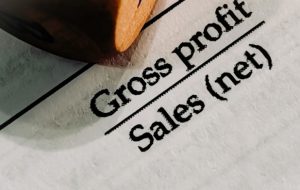It’s common to misunderstand the difference between gross profit and net profit. However, these are vital indicators of how well a company is performing. They provide crucial information about a company’s financial health, and it’s critical to grasp the distinction between them. Calculating your business profitability reveals how much money your firm makes. In addition, to assess growth, you may compare earnings from past accounting periods. Businesses must deal with and compute two forms of profit: gross profit and net profit.
To make business choices, compile accurate financial accounts, and track your financial health, you must understand gross profit vs net profit.
What exactly is gross profit?

Gross profit is a firm’s profit after subtracting the expenses of manufacturing and selling its goods or delivering its services. A company’s income statement calculates gross profit by subtracting the cost of goods sold (COGS) from revenue (sales). These data are often seen on a company’s credit report.
What can a company’s gross profit tell you?

Gross profit is the key indicator that defines a company’s profitability. This is because it represents a company’s efficiency in using its labor, raw materials, and other resources. A Creditsafe credit report will often depict a company’s profit and loss for the last five years and presents the company’s insight into its financial health and performance while assessing credit risk.
How is gross profit determined?

Revenue less than the cost of supplying the products or services equals gross profit.
The formula for gross profit:
Gross Profit equals to Cost of Goods Sold minus the Sales!
Profitability
What exactly is Net Profit?

Net profit is the selling price of your product less ALL operating expenses. This is the number we usually mean when we say profit (although it’s always worth double-checking).
What exactly is included in Net Profit?
Net profit comprises the same expenditures as gross profit and overheads or fixed costs like employees, rent, software, and bank charges.
How can I determine a company’s net profit?
Using a Creditsafe firm credit report, you can often discover a business’s net profit inside the Financials. The profit and loss section may include:
- A company’s operating earnings.
- Pre-tax profit.
- Retained profits.
- Pre-tax profit margin.
How do you compute net profit?
Net profit is calculated using the formula below:
Net Profit = Sales – (Cost of Goods Sold + Operating Expenses)
Said, net profit is the bottom line of a business. It is the amount that remains after subtracting all expenditures from total sales. — not just the cost of products sold but includes extra overheads and, in most cases, tax
Net profit vs gross profit

Profit is the total money gained by your company. The difference between gross and net profit is seen when expenses are subtracted.
Your company’s gross profit is the revenue less the cost of items sold. Your cost of goods sold (COGS) is the amount of money you spend directly on manufacturing your items. However, your company’s other costs are not reflected in your COGS. Your company’s gross profit is its profit before deducting expenditures.
Net profit is your firm’s revenue after deducting all operational, interest, and tax expenditures, as well as subtracting your COGS. You must first know your company’s gross profit to determine net profit. If the figure is negative, your company’s net profit is known as a net loss.
Depending on your expenditures, your company may have a high gross profit but a much smaller net profit.
Why is it essential to comprehend both net profit and gross profit?

Although gross earnings are the first to be calculated, they are also used for other purposes. Gross revenues demonstrate the financial health of your business relative to the price of the goods you provide. Therefore, gross profit may help measure how factors like your company’s production costs and labor expenses affect your bottom line before other costs like administrative fees are considered.
With your gross profit in hand, you may see your entire sales and how they are influenced by costs like raw materials, human labor, and facility taxes. This might be important in assessing whether or not there are any concerns affecting your gross margins. Common issues include overpaying for raw materials, setting inappropriate product prices, and employing more people than required. Let’s say you’ve found that most of your gross profits go toward raw material costs. If so, it could be time to find a new supplier for your goods.
Your company’s health and future cash flow may be better understood by looking at net profits. Your net profit may also be used as leverage to attract investors, unlike your company’s gross profit.
Investors want to know how their money will use before choosing which companies to support. If non-operational costs undermine your bottom line, even substantial gross profits are irrelevant—the likelihood of attracting investors increases when you generate a solid net profit.
When owning a small company, you must understand your gross and net earnings.
Giving lenders and investors your total profits won’t be enough; they want to know about your company’s financial stability. You must be aware of your company’s net income when looking for outside lenders. This allows investors and lenders to calculate how much money you have left after paying your bills.
Conclusion
As a small company owner, you probably believe your head is overburdened with formulae and financial information. However, knowing gross and net earnings may help you make more educated business choices. These selections may lead to additional charges, such as obtaining investors and helping you push your firm to new heights.
It will take time and probably some trial and error to calculate your gross and net income the first time. However, after a few attempts, you’ll be a seasoned pro, wondering how you ever made judgments without this vital information.
Making better business decisions? You don’t need the formula to recognize the importance of that talent.










Leave feedback about this